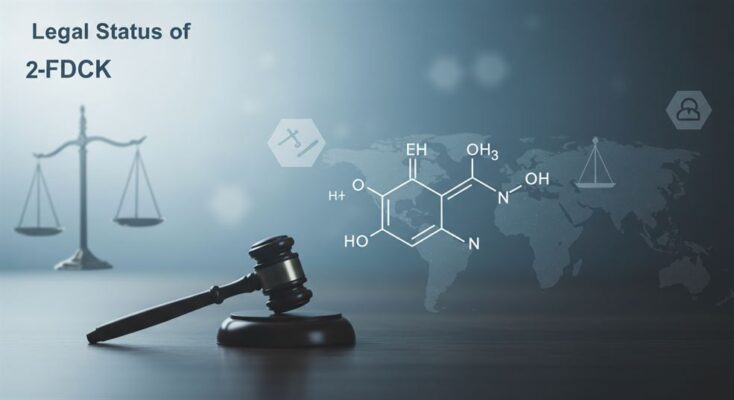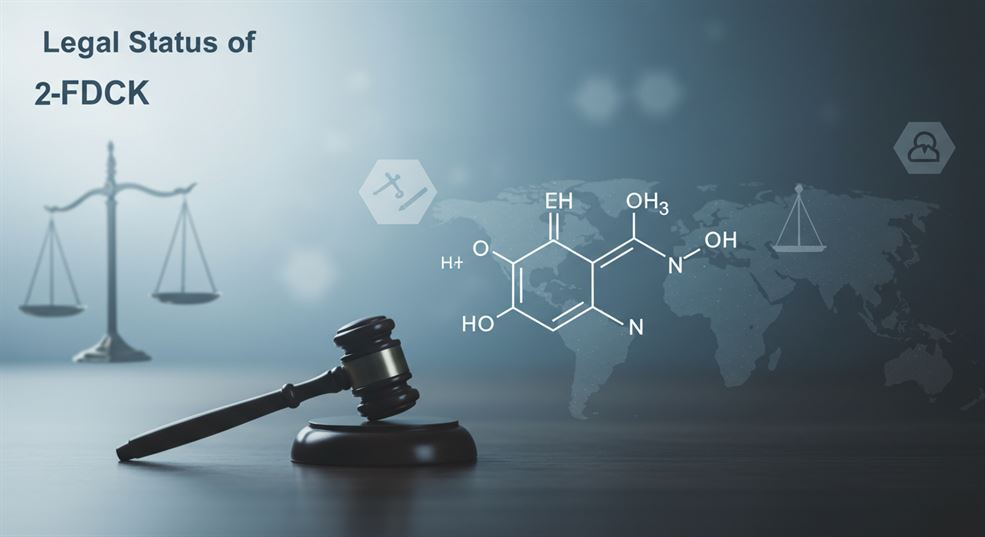The Legal Status of 2-FDCK: What You Need to Know in 2025
The Legal Status of 2-FDCK: What You Need to Know in 2025
2-Fluorodeschloroketamine (2-FDCK) is a dissociative compound structurally related to ketamine. Among these compounds, 2-Fluorodeschloroketamine (2-FDCK)—a ketamine analogue—has garnered attention for its psychedelic effects and murky legal standing. But where does it fall under global drug laws? Discover shocking secrets about the Legal Status of 2-FDCK that expose hidden laws and reveal explosive regulatory twists you never saw coming
What Is 2-FDCK?
2-FDCK, chemically known as 2-(2‑fluorophenyl)-2-(methylamino)cyclohexan‑1‑one, belongs to the arylcyclohexylamine class. Its structure closely mirrors that of ketamine—with a key substitution of a fluorine atom in place of chlorine—which results in a dissociative profile that has captured the interest of both researchers and recreational users. More detailed background information, including its synthesis and pharmacological properties, can be found on the Wikipedia page.
Global Legal Status of 2-FDCK: A 2024 Snapshot
Laws regulating 2-FDCK vary wildly by country, often lagging behind its emergence. Below is a breakdown of its current standing in key regions:
| Country/Region | Legal Status | Key Legislation |
|---|---|---|
| United States | Controlled (Analogue Act) | Controlled Substances Act |
| European Union | Mixed (Banned in some states) | EU New Psychoactive Substances Regulation |
| Canada | Illegal | Controlled Drugs and Substances Act |
| United Kingdom | Class B | Misuse of Drugs Act 1971 |
| Australia | Illegal | Poisons Standard |
The legal classification of 2-FDCK is not uniform around the world. Its novelty and limited research data have resulted in a patchwork of regulations. For example:
-
Illegal in Several Jurisdictions:
2-FDCK is explicitly banned in countries such as Italy, Japan, Latvia, Singapore, Sweden, and Switzerland. Moreover, blanket bans have been implemented in regions like Canada, Belgium, and the United Kingdom. These measures aim to curtail recreational use and potential health risks. For a concise summary of its legal status, see the detailed ChemicalBook profile.

-
Under Monitoring Elsewhere:
In the United States, 2-FDCK is currently not controlled under the Controlled Substances Act (CSA) despite evidence suggesting its abuse potential is comparable to ketamine. However, regulatory bodies are closely watching its emergence, and discussions regarding potential scheduling continue. The latest perspective from the Federal Register highlights that no approved medical uses exist and that additional controls may be necessary. -
European Regulatory Initiatives:
The European Commission has been proactive in addressing new psychoactive substances. Recent proposals advocate for adding 2-FDCK to Schedule II of the Convention on Psychotropic Substances. This initiative, detailed in the EU regulatory update, reflects the Union’s commitment to harmonize controls across Member States.
The U.S. Approach: Analogue Act Loopholes
In the U.S., 2-FDCK exists in a legal gray area. While not explicitly listed under the Controlled Substances Act, it may fall under the Federal Analogue Act, which bans substances “substantially similar” to Schedule I/II drugs. Prosecution hinges on proving intent for human consumption—a high legal bar. Still, the DEA has flagged 2-FDCK as a “drug of concern,” and states like Florida have outright banned it.
Europe’s Patchwork of Policies
The EU lacks a unified stance. Countries like Sweden and Germany classify 2-FDCK as illegal under analog laws, while others regulate it as a “research chemical.” The European Monitoring Centre for Drugs and Drug Addiction tracks its spread, noting increased seizures in 2023.
Why 2-FDCK’s Status Matters
The ambiguity surrounding 2-FDCK poses risks:
- Health Hazards: Limited research links it to bladder toxicity and cognitive impairment (PubMed study).
- Legal Peril: Possession in banned regions can lead to fines or imprisonment.
- Regulatory Challenges: Its online sale as a “research chemical” complicates enforcement.
Recent Regulatory Developments
The emergence of 2-FDCK on illicit markets has prompted regulatory agencies to reconsider its legal classification. In 2024, the World Health Organization’s Expert Committee on Drug Dependence recommended that 2-FDCK be placed in Schedule II of the Convention on Psychotropic Substances. This recommendation is gaining traction in the European Union, where measures are underway to standardize the control of novel psychoactive substances. These discussions underscore the substance’s potential public health risks and its similarity to established drugs like ketamine. For more in-depth comparisons, check out the analysis on Aimimichem.
Implications for Research and Public Health
While 2-FDCK’s legal ambiguity has facilitated its availability as a research chemical, it simultaneously presents challenges. Researchers value 2-FDCK for its unique dissociative properties and potential applications in neuropsychiatric studies. However, the lack of uniform regulation can lead to safety concerns, particularly if substances reach recreational markets where dosage and purity may be unregulated.
For laboratories and academic institutions, understanding local legislation is paramount before initiating studies with 2-FDCK. Ensuring that research complies with national and international laws not only protects researchers but also helps maintain high standards of scientific integrity. Public health experts emphasize the need for robust data on toxicity and dependency risks, which remains limited for this compound. Additional insights on these matters can be accessed via the UNODC substance details.

Comparative Legal Status Table
Below is a summary of the legal status of 2-FDCK in several key regions:
| Region/Country | Legal Status | Relevant Legislation/Notes |
|---|---|---|
| Italy | Illegal | Banned explicitly due to high abuse potential |
| Japan | Illegal | Controlled under national drug laws |
| Latvia | Illegal | National regulations ban its use |
| Singapore | Illegal | Misuse of Drugs Act prohibits its sale and distribution |
| Sweden | Illegal | Prohibited under health hazard regulations |
| Switzerland | Illegal | Banned under national drug control measures |
| Canada | Blanket Ban | Subject to comprehensive control measures |
| Belgium | Blanket Ban | Fully controlled under national laws |
| United Kingdom | Controlled (Class B) | Regulated under the Misuse of Drugs Act |
| United States | Not Controlled (yet under review) | Not scheduled under the CSA; potential future regulation pending additional data |
| European Union | Under Review | EU Commission proposal suggests Schedule II inclusion as per recent recommendations |
Frequently Asked Questions
What exactly is 2-FDCK and how does it differ from ketamine?
2-FDCK is a chemical analogue of ketamine, distinguished by the replacement of a chlorine atom with a fluorine atom in its molecular structure. This modification alters its dissociative effects and metabolism, making its impact similar yet distinct from ketamine. Detailed structural comparisons are available on Wikipedia.
Is 2-FDCK legal to purchase and use?
The legal status of 2-FDCK varies significantly by region. It is illegal in countries like Italy, Japan, Latvia, Singapore, Sweden, and Switzerland, while it is not currently controlled in the United States. In the EU, proposals are moving toward scheduling it under international conventions. For a comprehensive legal overview, refer to the ChemicalBook page.
What are the risks associated with using 2-FDCK outside of a research setting?
Outside of controlled research environments, the use of 2-FDCK poses several risks including unpredictable dosage, potential contamination, and adverse health effects such as dissociation and cardiovascular issues. These risks are compounded by its legal ambiguity, which can lead to misuse in unregulated markets. Regulatory updates in the Federal Register highlight these concerns.
How does the EU view 2-FDCK in terms of international drug control?
The European Commission is actively considering measures to include 2-FDCK in Schedule II of the Convention on Psychotropic Substances, driven by recommendations from the WHO Expert Committee on Drug Dependence. This move would harmonize its control across EU Member States and is detailed in the EU regulatory update.
What should researchers consider before working with 2-FDCK?
Researchers must be aware of the local legal framework regarding 2-FDCK, secure proper licenses, and follow safety protocols rigorously. Additionally, given the limited clinical data, thorough preclinical assessments should be conducted to evaluate its pharmacological and toxicological profiles. More comparative insights are available on Aimimichem.
Is 2-FDCK legal in the U.S.?
No—while not explicitly scheduled, it may be prosecuted under the Federal Analogue Act.
How does 2-FDCK differ from ketamine?
Chemically, it has a fluorine atom replacing chlorine. Effects are reportedly longer-lasting but less potent.
Can I buy 2-FDCK for “research purposes”?
Some vendors market it this way, but intent for human use can trigger legal action.
What are the penalties for possession?
Varies by country. In the UK, Class B possession carries up to 5 years in prison (Home Office).
Is 2-FDCK safer than ketamine?
No—lack of clinical studies means risks like addiction and organ damage remain understudied.
Navigating the Gray Areas
If you’re researching or considering 2-FDCK:
- Consult Legal Counsel: Laws change rapidly; seek expert advice.
- Prioritize Safety: Assume all NPS carry unknown risks.
- Stay Informed: Track updates via agencies like the UNODC.
Final Thoughts – The Shocking Legal Status of 2-FDCK
The legal status of 2-FDCK underscores the tension between evolving drug trends and outdated policies. As governments scramble to catch up, users and researchers alike must tread carefully. For now, its legality remains as elusive as its effects. For institutions looking to source high-quality research materials, ensure you only obtain 2-FDCK from reputable suppliers. Platforms like Cayman Chemicals and Aimimichem provide products that meet stringent quality standards, supporting both your research integrity and compliance with evolving legal norms.
Have questions or updates about 2-FDCK laws in your region? Share your insights in the comments—let’s crowdsource clarity.
Credible Sources:
- DEA Controlled Substances Act
- EMCDDA Report on NPS
- UK Misuse of Drugs Act
- PubMed Study on 2-FDCK
- UNODC Global Drug Policy
- Canadian Controlled Drugs Act
- ChemicalBook profile,
- UNODC substance details,
- EU regulatory updates,
- Wikipedia,
- Aimimichem,
- and the Federal Register.
Always verify local laws and consult professionals before making decisions.


